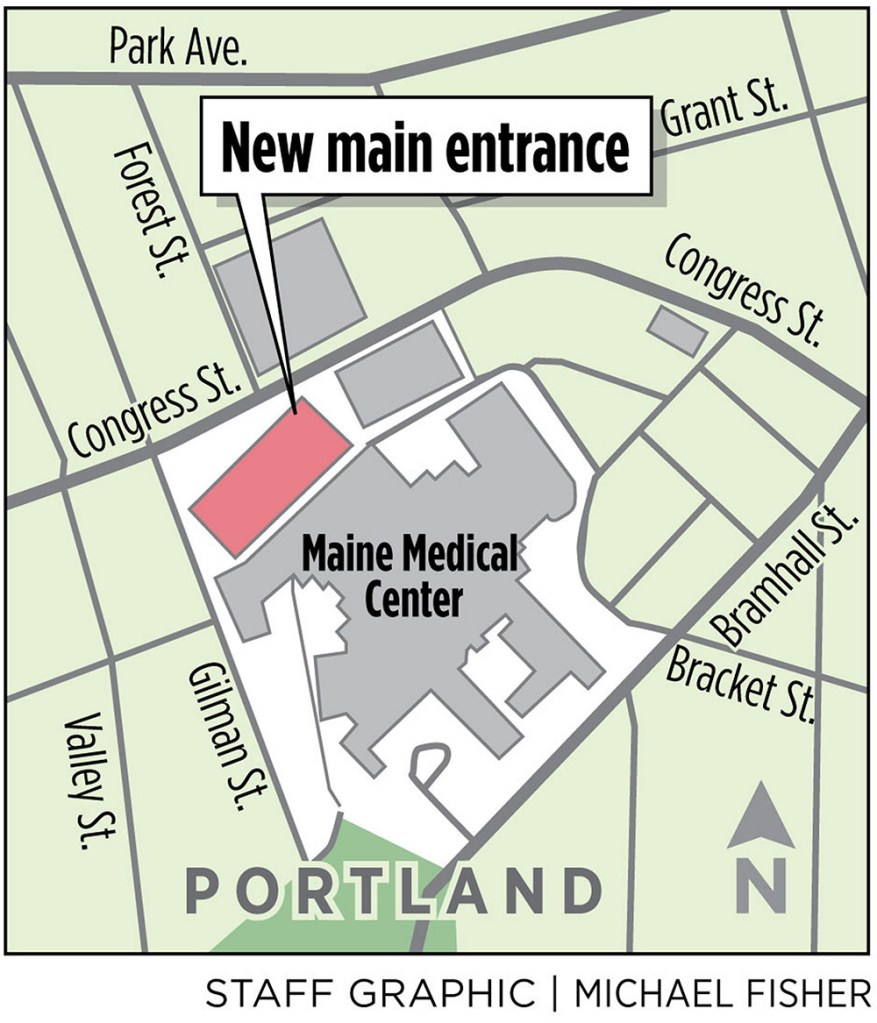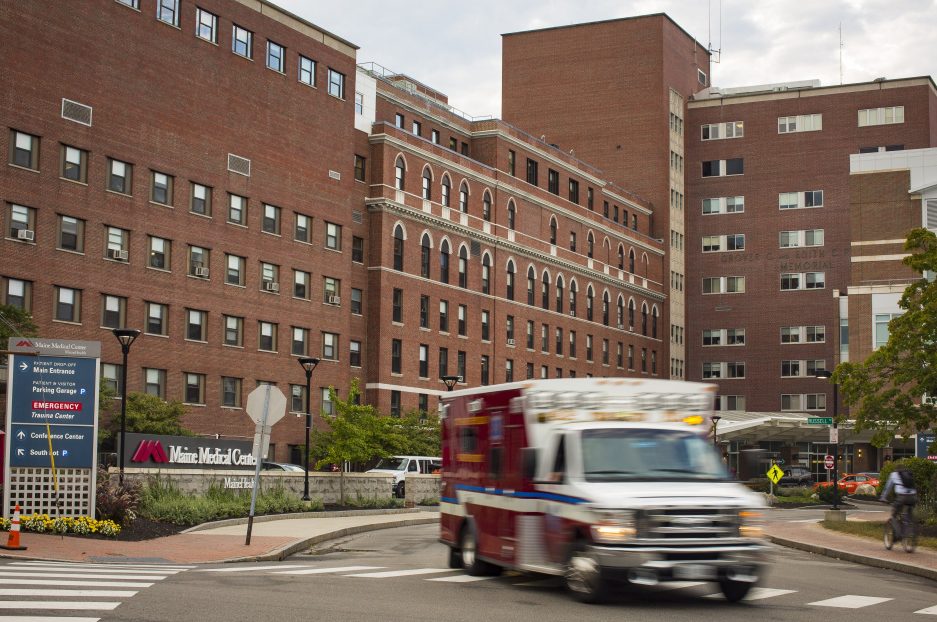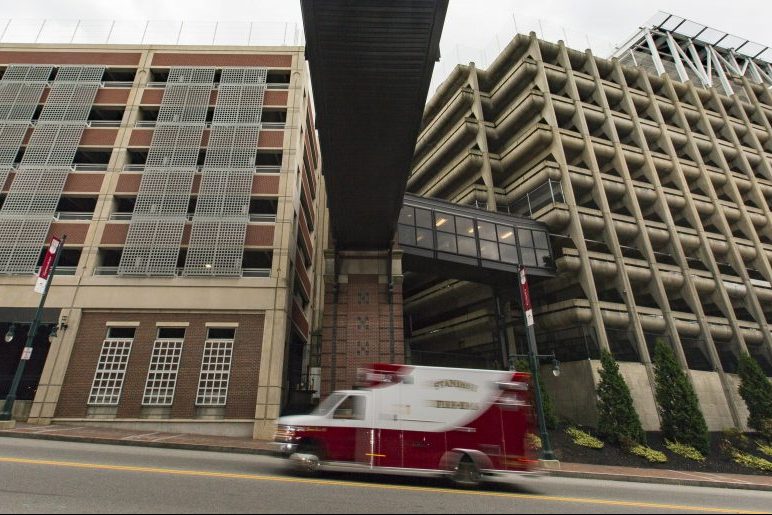Maine Medical Center has won state approval for its massive $512 million renovation and expansion project that will add single-patient rooms, operating rooms and a new entranceway facing Congress Street.
The Maine Department of Health and Human Services this week granted Maine Med a Certificate of Need, which is a state requirement to make sure that hospital expansion projects are necessary and would not duplicate services or increase health care costs.
“There has never been a doubt about the clinical need for this project. It has been clear to all that we need to expand and modernize to provide the best possible care for our patients,” Richard Petersen, Maine Med’s president and CEO, said in a statement Thursday.
The hospital still needs approvals from the city of Portland before it can begin construction.
The expansion project highlights the contrast between struggling rural hospitals and larger regional hospitals like Maine Med.
Maine’s hospitals – when Maine Med is excluded – were $50 million in the red in 2016, according to the Maine Hospital Association. Meanwhile, Maine Med operated with a $61 million surplus in 2016, according to the hospital’s annual financial disclosure.
If all goes as planned, Maine Med would break ground in the spring of 2018 and complete the project – the most extensive renovation in Maine Med’s history – by 2022. Maine Med, originally built in 1874, has expanded and upgraded numerous times throughout its history.
The expansion would increase the footprint of the hospital’s main campus by about 25 percent and add 19 new operating rooms and 128 single inpatient rooms. Hospitals have been moving away from double-occupancy rooms to help prevent the spread of infections and to increase patient comfort.
The cornerstone of the expansion would be a 270,000-square-foot building fronting Congress Street that would serve as the hospital’s main entrance and include 64 inpatient beds and the operating rooms.
Currently, the main entrance is on Bramhall Street, in the middle of the dense West End neighborhood.
The project did undergo one significant overhaul this summer, when the hospital changed its plans for parking from an adjacent site to a 10-story parking garage at 222 St. John Street, about a quarter mile from Maine Med. The new garage, with about 2,000 spaces, would be on property that the hospital already leases for surface parking for employees.
The existing parking garage on the Maine Med campus will be demolished. The original plan for a 13-story garage at Congress and Gilman streets was dropped after neighbors complained it would be too tall for the neighborhood.
“We have improved our original plan and created a solution that will serve the needs of our patients, our community and all of Maine,” said Jeff Sanders, Maine Med’s executive vice president and chief operating officer.
The state granted the Certificate of Need contingent upon Maine Med submitting annual reports on how the expansion improved “quality and outcomes” at the hospital. The reports are required for three years after the project is completed. There was a June public hearing at the Holiday Inn by the Bay in Portland, and no one spoke in opposition, said John Porter, director of marketing and communications for MaineHealth, Maine Med’s parent company.
Andrew Coburn, a professor of public health at the University of Southern Maine, said the trend across the country is for patients to bypass their local, rural hospital to go to larger hospitals like Maine Med for elective surgeries. That dynamic is making it difficult for rural hospitals to be financially viable, because the surgeries are among the most profitable for hospitals. At the same time, medical specialties are becoming concentrated at hospitals in urban centers.
The financial problems of rural hospitals surfaced most recently at Calais Regional Hospital, which closed its maternity services in August, causing a community backlash and complaints that women would have to drive hours to deliver babies. But Calais hospital officials said the facility was in a financial crisis and in danger of closing altogether if it didn’t cut services.
“There’s a lot of evidence that smaller hospitals are losing market share to the larger hospitals for specialty services,” Coburn said. “People are willing to drive hours out of their way.”
But Coburn said that Maine Med should not be blamed for struggles at other hospitals, as it is making logical choices based on “who is showing up at their door. They are in some respects responding to demand.”
Coburn said the state’s Certificate of Need process is a weak regulatory system, and it doesn’t take into account the overall picture of hospitals and the types of services they should or should not be providing. That would take a level of central planning for health care that’s not available in Maine or the United States, he said.
According to an August 2017 analysis by Maine DHHS, the hospital’s expansion project is necessary for modern hospital needs.
While Maine Med’s official capacity of 637 beds won’t change, standards for patient care have been updated over the past 20 years to require more patients be in single-occupancy rooms.
“Many of the patients treated at Maine Med today are simply too acutely ill to have roommates. This, combined with concerns such as matching patients in semi-private rooms with common infections or by gender, on a typical day leads to 60 or more bed closures. Capacity is further strained because many licensed beds are reserved for a specific purpose, notably patients requiring critical and intermediate care, often in emergent and urgent situations, and thus cannot be regularly used for inpatients with less urgent conditions,” according to the letter. “This will greatly ease the constraints now placed on Maine Med’s bed capacity.”
Roughly half of the expansion would be paid for with existing reserves and fundraising, and the other half through borrowing. Maine Med officials have said that the borrowing would represent a roughly 1 percent rise in current health care expenses at the hospital, although it’s difficult to measure the overall impact on health care costs.
The expansion also would add two floors with 30,000 square feet and 64 extra in-patient beds to the East Tower, which was built in 2009. In 2015, Maine Med completed a $40 million expansion by adding five operating rooms in a 40,000-square-foot, two-story addition.
The analysis also noted that the new operating rooms are needed because “surgeries and other procedures are also under stress at Maine Med. The vast majority of procedure rooms at the hospital are more than 30 years old. These facilities do not conform to current new building construction standards of size – they are about two-thirds the size of modern rooms – and supportive infrastructure such as prep and recovery bays, family waiting rooms and sterilization facilities are not properly suited to meet patient needs in the future.”
Joe Lawlor can be contacted at 791-6376 or at:
jlawlor@pressherald.com
Twitter; @joelawlorph
Send questions/comments to the editors.







Comments are no longer available on this story